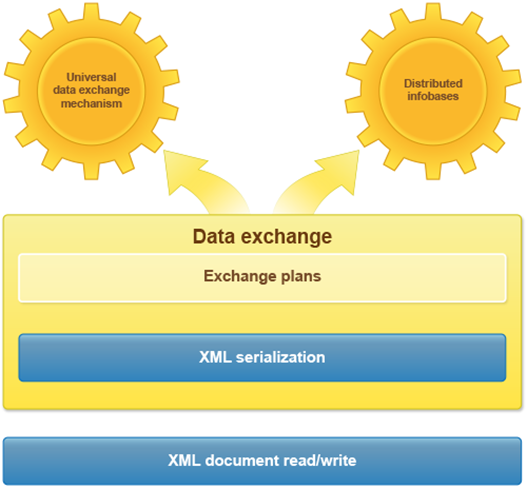Data exchange procedures allow for creating locally distributed data systems that exchange data offline, without a continuous connection. These procedures enable not only the integration between various 1C:Enterprise's infobases but also building complex heterogeneous data systems that incorporate third-party applications beside 1C:Enterprise solutions.
The platform powers two data exchange mechanisms:
-
The mechanism of distributed infobases is designed for the data exchange only with similar 1C:Enterprise configurations; it strictly specifies the created system's structure.
-
For one, the universal data exchange procedure allows for creating general distributed systems and imposes almost no limitations on the created system's structure.
Both of these mechanisms employ a set of the technological platform means that a developer may use separately or combine—depending on the specific task. Such an approach preconditions the exchange flexibility and adaptability to a wider range of tasks.
The range of platform tools used for creating data exchange procedures includes the following:
-
Exchange plans. These configuration objects allow for describing the list of nodes of a distributed data system to engage in the data exchange and setting the composition of data subject to the exchange.
-
XML serialization tools are designed to display various types of 1C:Enterprise 8 data in the form of XML data series, and vice versa.
-
XML document read/write tools allow for handling XML data on the base level, without linking to 1C:Enterprise objects.

What makes this mechanism set significant is that it ensures high system readiness to operating in a distributed environment; establishing the exchange requires very little extra development costs. The only thing required is to manually define data subject to the exchange, while the mechanism will enable message generation and uploading. With that, the platform automatically organizes only the exchange of the modified data, tracks message reception, determines the necessity for repeated message sending, allows collisions, and checks the input data integrity.
Flexible settings allow generating almost any exchange scheme topology (star, snowflake, no-center).
The user can select data subject to the exchange and collision permit rules at their own discretion. With that, the exchange mechanisms minimize the volume of the transmitted data (only modified data are transmitted) and ensure immunity against message loss. In other words, the system can operate either with guaranteed message delivery or without it.
Next page: Web services

